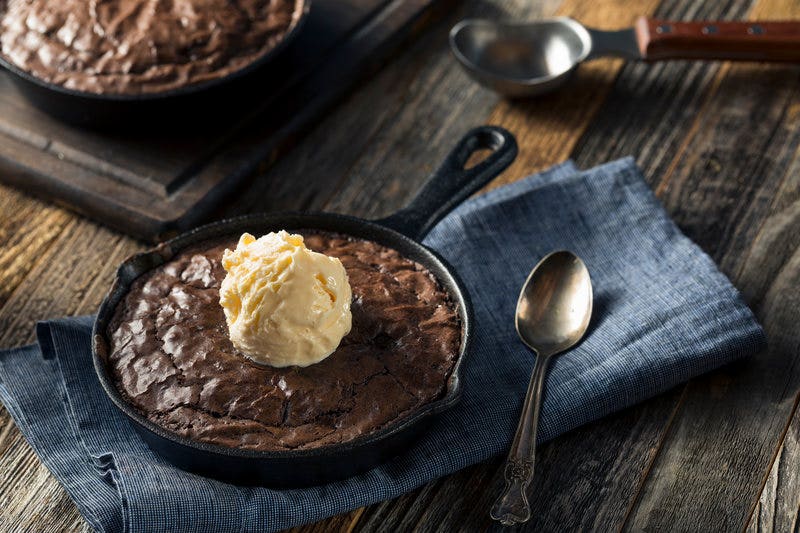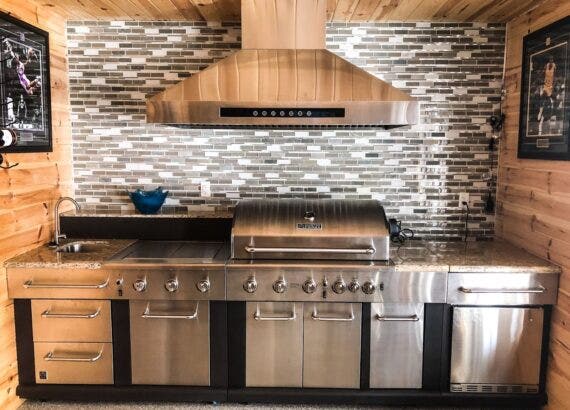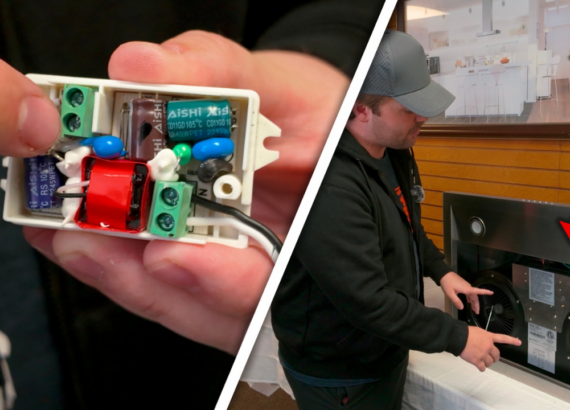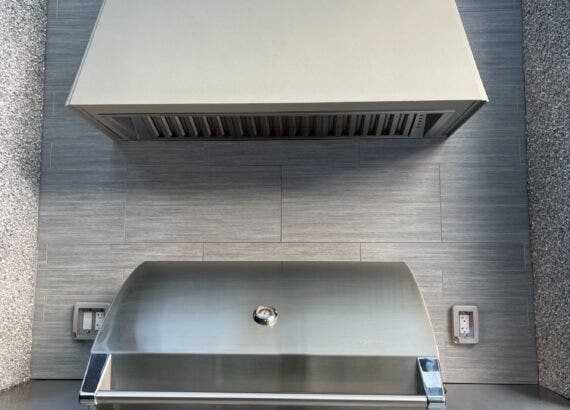Pros And Cons Of Cast Iron Skillets

Cast iron skillets are great pans for your kitchen. But everyone has their own cooking habits and behaviors. Depending on what you cook and how you like to cook, cast iron may not be right for you. It’s helpful to take a closer look at the pros and cons of cast iron skillets before you buy one for yourself.
If you do your research, you can find a skillet that will last you for years to come. More importantly, you’ll love to cook with it! Maybe it’s cast iron, but maybe it’s not. We won’t make the decision for you.
We’ll unpack five pros and five cons to help you make the right choice.
Table of Contents
Cast Iron Skillet Pros

Exceptionally Durable
Cast iron is arguably the most durable cookware on the market today. You might have a friend who uses a cast iron skillet their grandmother once used. They can be passed down for generations and still work great in the kitchen.
Cast iron contains two to four percent carbon which strengthens the material. Add a layer of polymerized oil to that and you have quite a durable cast iron skillet!
The seasoning can wear down, especially if you cook often at high heat or make acidic foods. So make sure you reseason your pan about twice a year.

Retains Heat Well
Cast iron is also one of the best materials for retaining heat. This means that once heated up, cast iron keeps its heat well. This makes it great for roasting, frying, and slow-cooking. High heat retention means less heat is lost throughout the cooking process. So food will cook much faster in cast iron compared to other materials.

Inexpensive
Cast iron pans are simple to make for manufacturers. They don’t need to worry about adding a special nonstick coating like Teflon to the pan before shipping. Also, cast iron skillets can last a lifetime. So they are a valuable long-term investment. You may spend $100 on a skillet and never have to buy another one.
You can find cast iron pans on sale from $15 to $500+. The main difference between these pans is the attention to detail of the manufacturing process. Expensive pans don’t skip any steps or use cheap materials as they craft their cookware. They are more durable than cheap pans, which take some shortcuts in the manufacturing process. A pan with a better finish also requires less reseasoning.
Lodge is one of the most popular brands of cast iron that make affordable cookware. Or if you’re interested in luxury cast iron, check out Finex or Le Creuset.

Naturally non-stick (with seasoning)
Once seasoned, cast iron pans slowly develop a completely non-stick coating. It takes some time for the coating to develop. The more you cook with your seasoned cast iron, and the better you care for it, the more non-stick it’ll become. But the key is it has to be seasoned well. Otherwise, all kinds of food will stick to your pan. That won’t be fun to clean!
Most pans today come pre-seasoned. Just check the product page or manufacturer’s instructions to see if yours requires seasoning. Some people prefer to remove the factory coating and season the pan themselves.
You’ll remove the factory coating when you first get your cast iron skillet or cookware. You might also remove the factory coating to tackle rust. Here’s a quick guide on stripping the seasoning and removing rust from your cast iron pan.

Supplements your food with additional iron
Each time you cook with your cast iron skillet, trace amounts of iron leach into your food. It’s not a dangerous amount – in fact, it can supplement your diet for the better. Research has shown that cooking with cast iron can be beneficial for people with anemia. But before you start cooking with it, consult your doctor.
We’re not medical professionals and every person is different. What works for you may not work for someone else!
Read more in our post, Is cooking with cast iron dangerous?
Cast Iron Skillet Cons

Heavy
Cast iron is a dense material, so it’s quite heavy. Cast iron skillets are difficult to maneuver so they’re not great for stir-frying.
Also, the pan will feel heavier than advertised because you’re lifting it with a handle. The further away the weight from your center of gravity, the harder it is to lift.
- 8” skillet: about 3 pounds
- 10” skillet: about 5 pounds
- 12” skillet: about 8 pounds
- 15” skillet: about 12 pounds

Heats unevenly
You probably have heard the opposite: that cast iron heats evenly. But this is actually a debunked myth. Cast iron is a poor heat conductor. This means that as you heat up your pan, it will get hot in the middle first and cooler on the sides. So, when cooking with cast iron, it’s important to preheat your skillet for about five to 10 minutes.
Also, make sure you’re using a large enough burner. If a burner is too small, your pan will get incredibly hot in the middle and will barely heat on the sides.
We debunked this and eight more myths in this article. Check it out.

Requires seasoning
Seasoning does take time and occasional maintenance (you’ll need to reseason your pan about twice a year), but it’s a small investment. You can get great value out of a seasoned cast iron pan.
That being said, if you don’t want to deal with seasoning and reseasoning your pan, avoid buying cast iron.

Difficult and costly to repair
If you crack your cast iron, your best bet is to replace it. Alternatives like welding or cast iron repair kits often end up being more expensive than replacing your pan. And you can’t always guarantee that the repair will last. So, if you’ve cracked your cast iron, broke the handle, or damaged it in any other way, replace it.

The handle can get dangerously hot
On most cast iron pans, the handle is also made of cast iron. This means it gets as hot as the pan itself. Handle the pan with care as you remove it from the oven. Use a hot pad or two when handling cast iron.
I recommend using two hands because cast iron is quite heavy. You don’t want to drop your pan as you take it out of the oven.
Frequently Asked Questions
What size cast iron skillet do I need?
If you live alone, an 8” skillet is great. 10” and 12” skillets are best for two to four people. These are the most popular sizes. A 15” skillet is best for five or more people. Save this skillet for large gatherings!
Learn more in this article.
How do I store cast iron?
Store your cast iron in a dry place – and make sure it’s dry too. You can store cast iron in a cabinet, pantry, on a pan rack, or even in the oven. Learn more in our article “How to Store Cast Iron.”
Is it OK to boil water in cast iron?
Yes, you can boil water in cast iron for up to 10 to 15 minutes. Any longer and the seasoning may start to chip away. Don’t cook with acidic foods for more than about 15 minutes either. They break down the seasoning more readily than other foods. Learn more here.
Can you ruin a cast iron skillet?
Yes, there are five main ways you can ruin your skillet. To keep your skillet in good condition:
- Don’t put it in the dishwasher.
- Don’t drop it.
- Clean it regularly and season it about twice a year.
- If rust accumulates, remove it.
- Avoid consistently intense high heat cooking. You can get away with it if you season your pan often. Keep an eye on the layer of seasoning. If it wears down after just a few uses, try turning the heat down when you’re cooking.
Is a cast iron pan worth it?
That depends on your cooking habits. For most people, cast iron pans are worth it because they don’t cost much and are incredibly durable. If you don’t fry, braise, roast, or slow-cook often, you probably don’t need a cast iron pan.
Can you put butter in a cast iron skillet?
You can put butter in a cast iron skillet, but it’s not recommended. For low-heat cooking, it’s great. But, butter burns at about 350º so you have to keep the heat down when using it. You can add some vegetable oil along with the butter to reduce the risk of burning.
Why is cast iron so cheap?
Cast iron is mostly made up of iron and carbon. This is pretty easy to manufacture cheaply. Manufacturers can skip steps in the process to make pans with a rougher finish. These are the cheapest types of pans. But you can also find cast iron pans with luxury finishes that don’t take shortcuts in the manufacturing process.
Can you cook eggs in a cast iron skillet?
Yes, but make sure it’s seasoned. Otherwise, your eggs will stick to the pan! Newly seasoned pans will be less non-stick than older pans.
Should you cook bacon in a cast iron skillet?
Yes, you can cook bacon in a cast iron skillet. In fact, the bacon grease helps season the pan, giving it a nice protective layer. If you cook with bacon often, you’ll have a non-stick pan in no time!
What did you think of the pros and cons? Does cast iron sound like it’s right for you? Ask around and see what other people cook with. How long has their cookware lasted? What’s their favorite dish to cook in cast iron?
Also, check out product reviews on Amazon or other sites. That way you can get firsthand info about cast iron skillets.
Remember, the more you cook with your cast iron, the more non-stick and rust-resistant it becomes.
To learn more about cast iron, check out the articles below!
Related Articles
History of Cast Iron (Infographic)
What size cast iron skillet do I need?
If you live alone, an 8” skillet is great. 10” and 12” skillets are best for two to four people. These are the most popular sizes. A 15” skillet is best for five or more people. Save this skillet for large gatherings!
Learn more in this article.
How do I store cast iron?
Store your cast iron in a dry place – and make sure it’s dry too. You can store cast iron in a cabinet, pantry, on a pan rack, or even in the oven. Learn more in our article “How to Store Cast Iron.”
Is it OK to boil water in cast iron?
Yes, you can boil water in cast iron for up to 10 to 15 minutes. Any longer and the seasoning may start to chip away. Don’t cook with acidic foods for more than about 15 minutes either. They break down the seasoning more readily than other foods. Learn more here.
Can you ruin a cast iron skillet?
Yes, there are five main ways you can ruin your skillet. To keep your skillet in good condition:
Don’t put it in the dishwasher.
Don’t drop it.
Clean it regularly and season it about twice a year.
If rust accumulates, remove it.
Avoid consistently intense high heat cooking. You can get away with it if you season your pan often. Keep an eye on the layer of seasoning. If it wears down after just a few uses, try turning the heat down when you’re cooking.
Is a cast iron pan worth it?
That depends on your cooking habits. For most people, cast iron pans are worth it because they don’t cost much and are incredibly durable. If you don’t fry, braise, roast, or slow-cook often, you probably don’t need a cast iron pan.
Can you put butter in a cast iron skillet?
You can put butter in a cast iron skillet, but it’s not recommended. For low-heat cooking, it’s great. But, butter burns at about 350º so you have to keep the heat down when using it. You can add some vegetable oil along with the butter to reduce the risk of burning.
Why is cast iron so cheap?
Cast iron is mostly made up of iron and carbon. This is pretty easy to manufacture cheaply. Manufacturers can skip steps in the process to make pans with a rougher finish. These are the cheapest types of pans. But you can also find cast iron pans with luxury finishes that don’t take shortcuts in the manufacturing process.
Can you cook eggs in a cast iron skillet?
Yes, but make sure it’s seasoned. Otherwise, your eggs will stick to the pan! Newly seasoned pans will be less non-stick than older pans.
Should you cook bacon in a cast iron skillet?
Yes, you can cook bacon in a cast iron skillet. In fact, the bacon grease helps season the pan, giving it a nice protective layer. If you cook with bacon often, you’ll have a non-stick pan in no time!







Comments are closed.